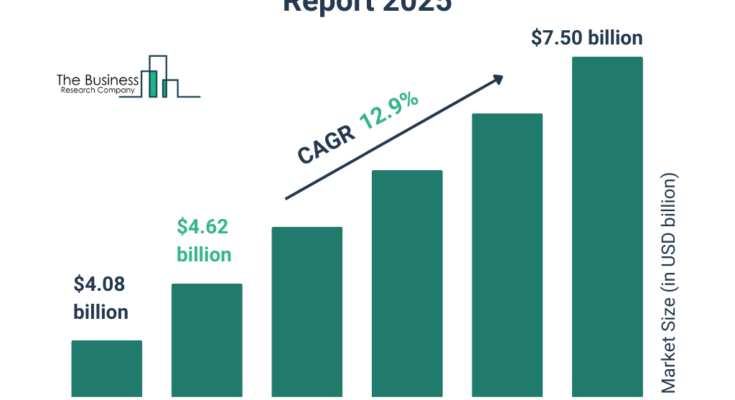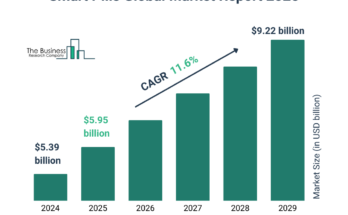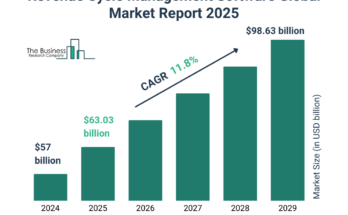What is the present valuation and projected CAGR of the acute care syndromic testing market?
The acute care syndromic testing market size has grown rapidly in recent years. It will grow from $4.08 billion in 2024 to $4.62 billion in 2025 at a compound annual growth rate (CAGR) of 13.2%. The growth in the historic period can be attributed to increase in awareness of antimicrobial resistance, rise in government funding for infectious disease, increase in investment in healthcare infrastructure, increase focus on syndromic testing, expansion of telemedicine and rise in infectious disease.
The acute care syndromic testing market size is expected to see rapid growth in the next few years. It will grow to $7.50 billion in 2029 at a compound annual growth rate (CAGR) of 12.9%. The growth in the forecast period can be attributed to rising prevalence of infectious diseases, growing demand for faster diagnostic solutions, expansion of healthcare services, rising use of multiplex syndromic panels, and growing geriatric population. Major trends in the forecast period include shift toward point-of-care testing, integration of cloud-based platforms, adoption of multiplex panels, development of AI-powered tools, and automation in syndromic testing.
Get Your Free Sample of The Global Acute Care Syndromic Testing Market Report:
https://www.thebusinessresearchcompany.com/sample.aspx?id=21078&type=smp
What key drivers have fueled the acute care syndromic testing market’s development over the years?
The growing incidence of infectious diseases is expected to propel the acute care syndromic testing market going forward. Infectious diseases are illnesses caused by harmful microorganisms such as bacteria, viruses, fungi, or parasites that can spread from person to person, animals, or the environment. The growing incidence of infectious diseases is driven by factors such as population growth, urbanization, global travel, antimicrobial resistance, and climate change, increasing the need for effective prevention and treatment. Acute care syndromic testing is used in infectious diseases to rapidly identify pathogens and co-infections through multiplex molecular diagnostics, enabling targeted treatment decisions. For instance, in February 2024, according to the Health Security Agency, a UK-based government agency, in week 4 of 2024, the influenza positivity rate increased to 16.6%, up from 14.0% the previous week. Influenza-like illness (ILI) consultations also rose, reaching 9.8 per 100,000 people, compared to 7.5 per 100,000 in the prior week. Additionally, influenza hospitalizations climbed to 7.63 per 100,000, up from 5.12 per 100,000 the week before. Therefore, the growing incidence of infectious diseases is driving the acute care syndromic testing market.
What is the segmentation for the acute care syndromic testing market?
The acute care syndromic testing market covered in this report is segmented –
1) By Disease Type: Respiratory Diseases, Gastrointestinal Diseases, Genitourinary Diseases, Tropical Diseases, Other Disease Types
2) By Sample Type: Blood, Urine, Biofluids, Stool, Swabs, Other Sample Types
3) By Target: Bacteria, Viruses, Fungi, Parasites
4) By End User: Hospitals, Clinical And Diagnostic Laboratories, Research And Academic Institutions, Other End Users
Subsegments:
1) By Respiratory Diseases: Influenza, Respiratory Syncytial Virus (RSV), COVID-19, Tuberculosis, Other Respiratory Diseases
2) By Gastrointestinal Diseases: Clostridium Difficile Infection, Norovirus, Rotavirus, Salmonella, Other Gastrointestinal Diseases
3) By Genitourinary Diseases: Urinary Tract Infections (UTIs), Sexually Transmitted Infections (STIs), Vaginal Infections, Other Genitourinary Diseases
4) By Tropical Diseases: Malaria, Dengue, Chikungunya, Zika Virus, Other Tropical Diseases
5) By Other Disease Types: Meningitis, Sepsis, Other Emerging Infectious Diseases
Order your report now for swift delivery
https://www.thebusinessresearchcompany.com/report/acute-care-syndromic-testing-global-market-report
Who are the most influential companies in the acute care syndromic testing market?
Major companies operating in the acute care syndromic testing market are Siemens Healthineers AG, F. Hoffmann-La Roche Ltd, Thermo Fisher Scientific Inc., Danaher Corporation, Becton, Dickinson and Company, Seegene Inc., bioMérieux SA, Sysmex Corporation, Bio-Rad Laboratories Inc., QIAGEN N.V., Werfen, DiaSorin S.p.A., Quidel Corporation, Luminex Corporation, Biocartis NV, Microbiologics Inc., QuantuMDx Group Ltd., Curetis GmbH by OpGen Inc., Genetic Signatures Ltd., Applied BioCode Inc.
What are the top industry trends projected to impact the acute care syndromic testing market?
Major companies operating in the acute care syndromic testing market are focusing on technological advancements such as multiplex real-time polymerase chain reaction (PCR) technology to enhance diagnostic accuracy, enable rapid pathogen detection, streamline laboratory workflows, reduce turnaround time, and improve patient outcomes through precise and timely treatment interventions. Multiplex real-time PCR technology is an advanced molecular diagnostic method that simultaneously detects and quantifies multiple pathogens or genetic targets in a single PCR reaction, improving efficiency and accuracy in disease diagnosis. For instance, in April 2023, QIAGEN N.V., a Netherlands-based biotechnology research company, launched the QIAstat-Dx syndromic testing solution in Japan, featuring a SARS-CoV-2 respiratory panel that detects over 20 pathogens from a single sample. Using multiplex real-time PCR technology, it delivers rapid results with minimal labor compared to individual PCR assays. By the end of 2022, over 3,500 systems were installed globally, supporting the diagnosis of respiratory, gastrointestinal, and meningitis-related conditions. The system is available in over 100 countries, enhancing syndromic testing accessibility worldwide.
What are the major regional insights for the acute care syndromic testing market, and which region holds the top position?
North America was the largest region in the acute care syndromic testing market in 2024. The regions covered in the acute care syndromic testing market report are Asia-Pacific, Western Europe, Eastern Europe, North America, South America, Middle East, Africa.
What Does The Acute Care Syndromic Testing Market Report 2025 Offer?
The acute care syndromic testing market research report from The Business Research Company offers global market size, growth rate, regional shares, competitor analysis, detailed segments, trends, and opportunities.
Acute care syndromic testing refers to a rapid molecular diagnostic approach that detects multiple pathogens simultaneously from a single patient sample. It is used in emergency and critical care settings to quickly diagnose infectious diseases. This enables faster treatment decisions, improved patient outcomes, and reduced hospital stays.
Purchase the exclusive report now to unlock valuable market insights:
https://www.thebusinessresearchcompany.com/purchaseoptions.aspx?id=21078
With over 15000+ reports from 27 industries covering 60+ geographies, The Business Research Company has built a reputation for offering comprehensive, data-rich research and insights. Armed with 1,500,000 datasets, the optimistic contribution of in-depth secondary research, and unique insights from industry leaders, you can get the information you need to stay ahead.
Our flagship product, the Global Market Model, is a premier market intelligence platform delivering comprehensive and updated forecasts to support informed decision-making.
Contact Us:
The Business Research Company
Europe: +44 207 1930 708
Asia: +91 88972 63534
Americas: +1 315 623 0293
Email: info@tbrc.info
Follow Us On:
LinkedIn: https://in.linkedin.com/company/the-business-research-company
Twitter: https://twitter.com/tbrc_info
Facebook: https://www.facebook.com/TheBusinessResearchCompany
YouTube: https://www.youtube.com/channel/UC24_fI0rV8cR5DxlCpgmyFQ
Blog: https://blog.tbrc.info/
Healthcare Blog: https://healthcareresearchreports.com/
Global Market Model: https://www.thebusinessresearchcompany.com/global-market-model



